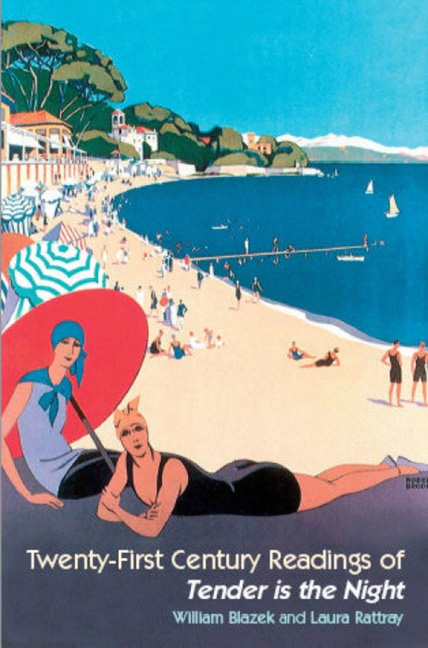Book contents
- Frontmatter
- Contents
- Acknowledgements
- List of Illustrations
- Introduction
- 1 ‘Can't We Put it in Writing?’: Some Short Precursors to Tender Is the Night
- 2 Tender Is the Night, ‘Jazzmania’, and the Ellingson Matricide
- 3 Sanatorium Society: The ‘Good’ Place in Tender Is the Night
- 4 ‘Some Fault in the Plan’: Fitzgerald's Critique of Psychiatry in Tender Is the Night
- 5 An ‘Unblinding of Eyes’: The Narrative Vision of Tender Is the Night
- 6 Si le soleil ne revenait pas: Swiss Clockwork Gone Mad in Tender Is the Night
- 7 ‘A Unity Less Conventional But Not Less Serviceable’: A Narratological History of Tender Is the Night
- 8 American Riviera: Style and Expatriation in Tender Is the Night
- 9 ‘Out Upon the Mongolian Plain’: Fitzgerald's Racial and Ethnic Cross-Identifying in Tender Is the Night
- 10 Gender Anxiety: The Unresolved Dialectic of Fitzgerald's Writing
- 11 Tender Is the Night and the Calculus of Modern War
- 12 Reading Fitzgerald Reading Keats
- Notes on Contributors
- Index
7 - ‘A Unity Less Conventional But Not Less Serviceable’: A Narratological History of Tender Is the Night
- Frontmatter
- Contents
- Acknowledgements
- List of Illustrations
- Introduction
- 1 ‘Can't We Put it in Writing?’: Some Short Precursors to Tender Is the Night
- 2 Tender Is the Night, ‘Jazzmania’, and the Ellingson Matricide
- 3 Sanatorium Society: The ‘Good’ Place in Tender Is the Night
- 4 ‘Some Fault in the Plan’: Fitzgerald's Critique of Psychiatry in Tender Is the Night
- 5 An ‘Unblinding of Eyes’: The Narrative Vision of Tender Is the Night
- 6 Si le soleil ne revenait pas: Swiss Clockwork Gone Mad in Tender Is the Night
- 7 ‘A Unity Less Conventional But Not Less Serviceable’: A Narratological History of Tender Is the Night
- 8 American Riviera: Style and Expatriation in Tender Is the Night
- 9 ‘Out Upon the Mongolian Plain’: Fitzgerald's Racial and Ethnic Cross-Identifying in Tender Is the Night
- 10 Gender Anxiety: The Unresolved Dialectic of Fitzgerald's Writing
- 11 Tender Is the Night and the Calculus of Modern War
- 12 Reading Fitzgerald Reading Keats
- Notes on Contributors
- Index
Summary
The putative faults of Tender Is the Night are widely known: since its 12 April 1934 publication, F. Scott Fitzgerald's fourth novel has been criticized for its amorphous structure and unwieldy form; for the non-chronological presentation of Dr Dick Diver's ‘dying fall’; and for the inconsistencies in characterization that (supposedly) obscure both the etiology of the chief protagonist's dissolution and the attendant rehabilitation of his mentally unstable wife, Nicole Warren Diver. Although not without its early defenders (particularly the New York Times's John Chamberlain and Modern Monthly's C. Hartley Grattan), the novel was greeted with lukewarm reviews due mainly to its diffuseness, which was alternately attributed to its nine-year incubation, its multiple aborted drafts, and even its author's financial dependency on the commercial short-story market (which, it was said, distracted him from mastering the craft of novel writing).
During the Fitzgerald revival of the 1950s, at the height of New Criticism, Tender was deemed the red-headed stepson compared to The Great Gatsby's perfect child. In that same period, biographical readings inspired by the popularity of Arthur Mizener's The Far Side of Paradise (1951) insisted that the book's flaws were byproducts of Fitzgerald's alcoholism and the strains of Zelda Sayre Fitzgerald's breakdown, which had kept her institutionalized for much of 1930 on. Even today, long after the formalist obsession with unity gave way to the academy's current celebration of disjunctive and polyphonic narratives, the amorphous nature of Tender continues to win it the reputation of a ‘flawed’ or ‘imperfect’ novel; it is a work, critics say, whose experimental qualities are more a byproduct of its troubled textual history than the deliberate anti-conventionalism of Ulysses, Mrs Dalloway, or Absalom, Absalom!
As the citations above suggest, much of the discussion of Tender's faults centres upon its form and structure. Within this body of criticism, however, are far less pronounced yet no less intense reservations about the novel's narrative strategies. In F. Scott Fitzgerald: His Art and his Technique (1964), James E. Miller, Jr, catalogues its panoply of storytelling techniques, including epistolary narrative, stream of consciousness, and omniscient editorializing, all of which somehow add up to less than their sum of their parts:
- Type
- Chapter
- Information
- Twenty-First Century Readings of ‘Tender is the Night’ , pp. 121 - 142Publisher: Liverpool University PressPrint publication year: 2007



